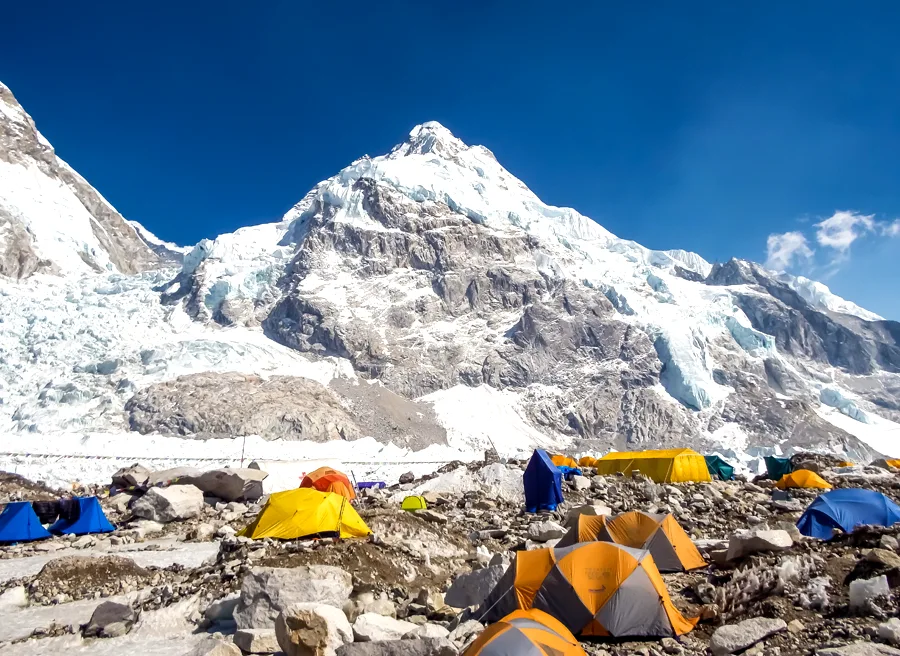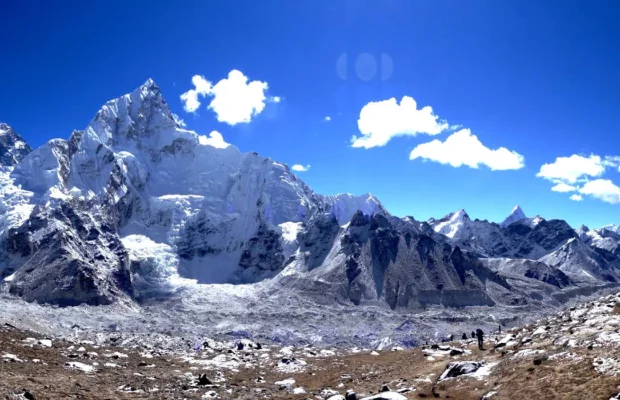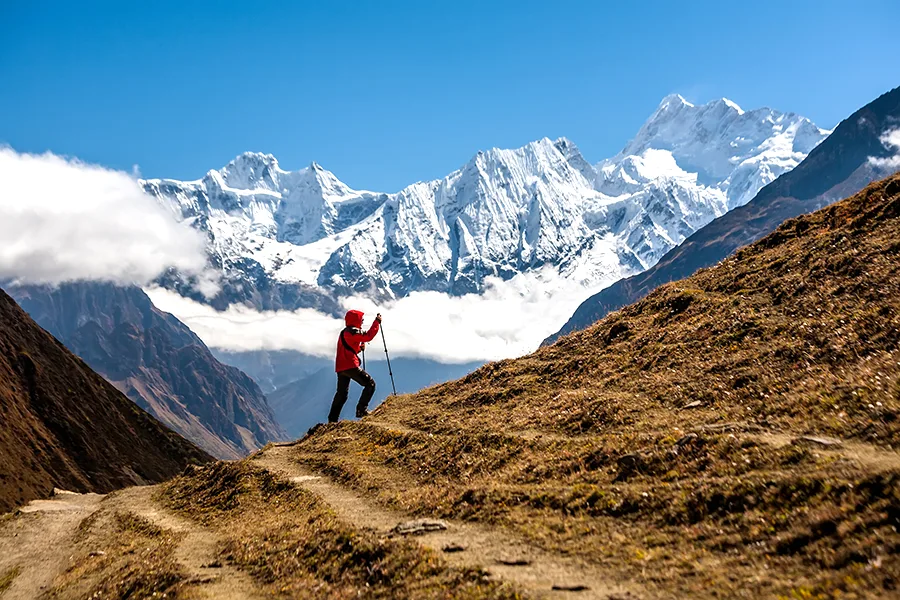Everest Base Camp Trek in Winter, advantages and disadvantages
Planning for Everest Base Camp Trek in Winter turns it right into a special and tough journey. In winter, it is very cold, and the trails are full of snow, making the journey extra non-violent. Since fewer human beings trek at some point during this time, the trails are quieter.
The clear skies show off incredible views of the huge mountains. It’s perfect for people who love taking photographs. Even though it’s calm and beautiful, winter hiking has its challenges like truly cold weather and snowy trails.
If you are looking for a calm trek and are prepared to withstand winter-demanding situations, going to Everest Base Camp Trek in winter can be a cool and satisfying adventure. Trekking to Everest Base Camp throughout winter is hard however it brings fantastic rewards.
Winter in the Everest location commonly takes place from late December to February. During this time there is severe cold, and temperatures can plummet, especially at higher altitudes.
Explore the Wonders of Everest Base Camp Trek in Winter

Everest Base Camp Trek in winter is a tremendous adventure that offers beautiful perspectives and a chance to revel in different cultures. It’s now not just an easy walk; it is a ride that helps you to discover the splendor of the sector’s maximum peaks.
This journey satisfies your love for excitement and makes you admire the beauty of Mount Everest. With beautiful scenery and cultural tales at each step, this trek is hard to discover and enjoy the splendor of nature.
The Gateway: Lukla Airport
The journey begins at Lukla Airport, known as one of the maximum hard airports in the international. The brief and exhilarating flight from Kathmandu gives breathtaking views of the Himalayan variety.
The tiny airstrip nestled on a steep mountain slope serves as the gateway to the Khumbu place, in which the trek to Everest Base Camp officially commences.
Namche Bazaar: The Sherpa Heartland
The trail passes via beautiful villages and dense forests, exploring the location to Namche Bazaar. A vibrant market city in the middle of the Khumbu district wherein tourists take time to accustom themselves to the upscale markets and find out about the Sherpa existence avenue map.
Tengboche Monastery: Spiritual Serenity
Then, the trek continues to Tengboche, in which you will discover the well-known Tengboche Monastery. Surrounded by colorful forests, this nonviolent spot is an important vacation spot for tourists searching for a religious experience.
The prayers of the priests and the sight of Mount Everest create a completely unique environment that reflects the peace and spirituality of the Himalayas.
Dingboche: Gateway to High Altitude Trekking
As the path ascends in addition, trekkers reach Dingboche, a high-altitude village surrounded by stone partitions to guard in opposition to the cruel winds. This is a crucial factor before heading to the more difficult terrains. The perspectives of Ama Dablam from here are nothing short of surprising.
Lobuche and Gorak Shep: Approaching the Base Camp
Lobuche serves as a resting factor before the final push to Gorak Shep, the ultimate agreement earlier than Everest Base Camp. The trail unveils beautiful vistas of the Khumbu Glacier and the formidable Khumbu Icefall. Gorak Shep itself gives a preview of the barren landscapes of the Everest vicinity.
The Everest Base Camp: Where Dreams Converge
The best part of the Everest Base Camp Trek in Winter is, of course, the Everest Base Camp. With the majestic Khumbu Glacier within the heritage and the peaks of Mount Everest in front of you, reaching this factor is a super fulfillment. Travelers often share stories and enjoy breathtaking views of Everest, Nuptsey, and Pumori.
Kala Patthar: The Ultimate Viewpoint
Many trekkers climb to an area known as Kala Pathar for the most wonderful view of Everest. At an altitude of 5,545 meters (18,192 ft), it gives a dreamlike view of the dawn over Everest, Lhotse, and the entire Khumbu Valley. When you reach this height, the feeling of success is really special.
Cultural Encounters: Sherpa Hospitality
Beyond the herbal wonders, the Everest Base Camp trek offers an opportunity to connect with the Sherpa people and their wealthy cultural history. Trekkers often go to neighborhood monasteries, take part in conventional rituals, and gain a perception into the everyday lives of the mountain groups.
Challenges and Rewards: The Trekker’s Journey
The Everest Base Camp trek in winter isn’t without its worrying situations. Altitude sickness, unpredictable weather, and rugged terrain demand bodily health. But every step is rewarded with breathtaking landscapes, camaraderie among fellow vacationers, and the remarkable pride of being on the foot of the best mountain inside the world.
Himalayan Biodiversity Conservation: Responsible Travel
As Everest Base Camp trekking grows in popularity during the summer, so does the need for responsible travel. Sustainable practices, waste management, and respect for neighboring cultures are essential to preserve fragile Himalayan soils for future generations.
The Everest Base Camp Trek in winter is a combination of the trek of a lifetime, natural wonders, cultural memories, and private adventures.
From the challenging Lukla runway to the long view of Everest, every step of this trek becomes an economical breakthrough in an incredible journey, providing travelers with reminders of what it is ultimately all about for the rest of life.
Whether you are an avid hiker or a specialist in time travel, the Everest Base Camp Trek in winter promises its majestic splendor and transformative pleasures.
Explore the advantages of Everest Base Camp Trek in Winter
Going for the Everest Base Camp trek in winter months gives an exclusive and much less-traveled revel in. The benefits of this adventure in wintry weather consist of serene landscapes, reduced crowds, clearer skies, and particular demanding situations.
While the colder temperatures and ability logistical hurdles are elements to not forget, the ones looking for a quieter, greater adventurous trek may additionally locate the winter season to be a perfect time to discover the iconic Everest location.
1. Less Crowded:
Winter sees fewer trekkers, offering a quieter and greater peaceful enjoyment without the crowds that you would possibly encounter in the course of the peak trekking season.
2. Clear Views:
Winter frequently brings clear skies and incredible visibility, supplying breathtaking perspectives of the snow-capped peaks without the haze that could obscure them in the course of other seasons.
3. Photography Opportunities:
The pristine snowy landscapes create a picturesque setting, imparting precise and beautiful photo opportunities that you may not get for the duration of other times of the year.
4. Challenging Adventure:
The trek becomes more challenging due to the colder temperatures and snow-protected trails, including a further layer of adventure and excitement for those in search of an extra annoying experience.
5. Unique Experience:
Experiencing Everest Base Camp Trek in winter weather affords a distinct perspective, allowing you to witness the area in a less-ordinary setting, presenting a unique and memorable revel in.
6. Lower Prices:
Accommodation and services may be greater and less costly in the wintry weather months, making it a financially pleasant option for those seeking to trek to Everest Base Camp without breaking the financial institution.
7. Cultural Interaction:
While the winter months are quieter for tourism, it allow for extra intimate interactions with the local Sherpa communities, presenting a deeper information of their subculture and manner of lifestyles.
Explore the disadvantages of Everest Base Camp Trek in Winter
Starting off the Everest Base Camp trek in winter provides its very own set of demanding situations and considerations. While the quieter trails and unique wintry weather landscapes may add enchantment to a few, potential drawbacks encompass severe cold, confined centers, and the danger of weather-related disruptions.
Trekkers ought to navigate snowy paths, deal with shorter days, and be prepared for the increased likelihood of flight delays. Despite these disadvantages, the ones seeking a more difficult and solitary journey may additionally locate the wintry weather trek to Everest Base Camp a profitable undertaking.
1. Extreme Cold:
Winter temperatures at excessive altitudes may be extremely cold, offer challenges for trekkers who want to bear harsh climate conditions, specifically for the duration of nights and early mornings.
2. Limited Tea Houses:
Some tea houses alongside the direction can be closed throughout wintry weather due to the lower in visitor visitors, restricting lodging options and necessitating extra cautious planning.
3. Snow-Covered Trails:
The hiking trails may be covered in snow, making the adventure more bodily disturbing and doubtlessly increasing the threat of slips and falls.
4. Shorter Days:
Winter days are shorter, which means much less daylight hours for hiking. This can restrict the gap covered every day and can require early starts off evolved to maximize sunlight hours.
5. Flight Delays:
Winter weather can lead to flight delays or cancellations inside and out of Lukla, the place to begin the trek, inflicting demanding situations and disruptions in your journey.
6. Risk of Altitude Sickness:
Cold temperatures blended with excessive altitudes boom the threat of altitude sickness. Trekkers want to acclimatize well and be aware of the symptoms to avoid serious fitness troubles.
7. Limited Flora and Fauna:
The wintry weather landscape is devoid of the vibrant plants and animals that flourish during other seasons, resulting in a much less colorful and various hiking environment.
Before beginning the Everest Base Camp trek in winter, it is critical to be well-prepared, have suitable tools, and remember the demanding situations related to the winter season. Additionally, consulting with guides and tracking climate conditions is important for a secure and exciting trek.
The Final Wrap Up
Going for Everest Base Camp Trek in winter requires careful consideration of the challenges and unique rewards it offers. The secluded setting, clean atmosphere, and clear views make it attractive to seekers.
A thoughtful and intimate Himalayan experience. But it’s bitterly cold and the challenging trail conditions demand good preparation and a resilient spirit. For those willing to embrace the winter chill, the Everest Base Camp trek in winter becomes a canvas of snow-laden wonders, offering a quieter, more reflective journey to the roof of the world.








